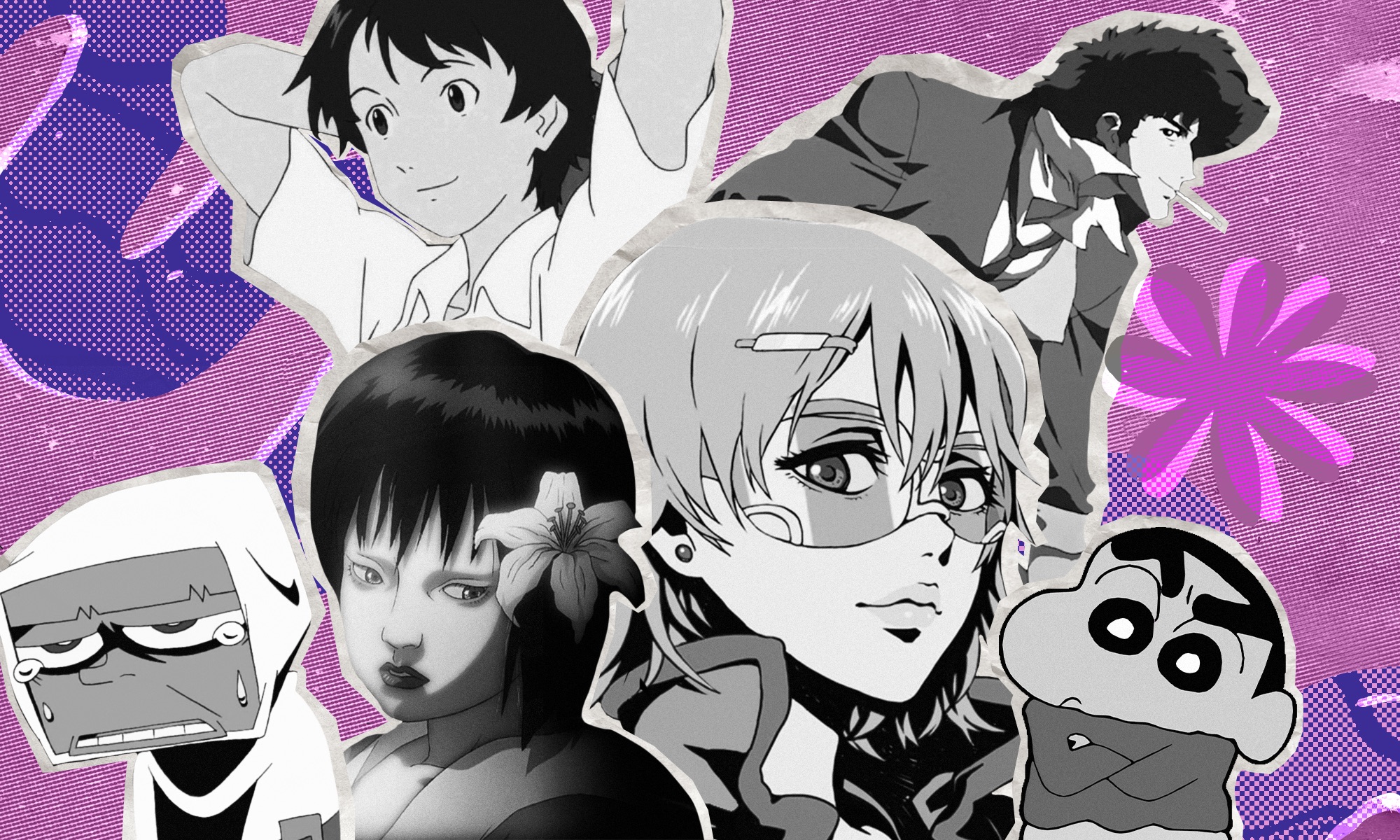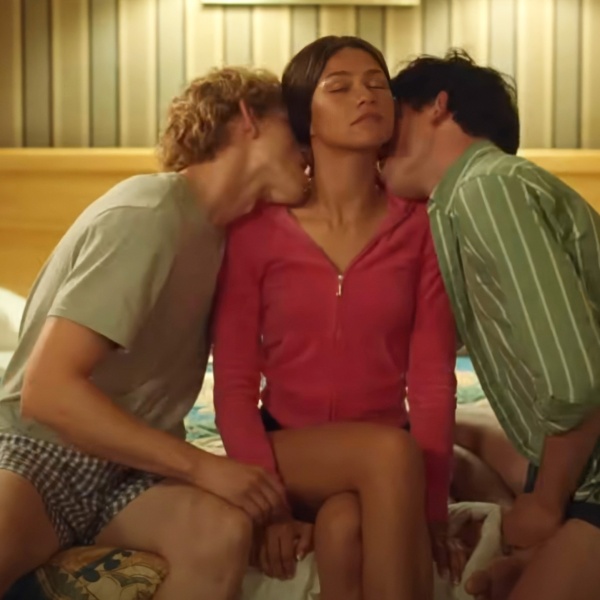
This article is part of IndieWire’s 2000s Week celebration. Click here for a whole lot more.
The 2000s were a period of great technological change for anime. The DVD boom brought the industry to the West like never before (while inspiring Western money along with it), and traditional cel animation began to be entirely taken over by digital painting while many artists continued exploring the possibilities of CGI; according to “Anime: A History” author Jonathan Clements, the last cel-animated anime was “Sazae–san“ in 2007.
There was certainly a lot to like, as so many new and vastly influential creators were taking their first steps into the industry. In 2002, the great Makoto Shinkai created “Voices of a Distant Star” almost entirely on his own. Elsewhere, Hayao Miyazaki won anime’s first Oscar for “Spirited Away,” while the late Satoshi Kon fully emerged as one of the world’s best and most prescient filmmakers with the likes of “Tokyo Godfathers” and “Paprika” (to say nothing of his serialized “Paranoia Agent”). Kon’s name appears in this list of the best anime films of the decade, though you may notice the purposeful exclusion of Studio Ghibli, which isn’t a knock against the company’s output so much as an acknowledgment of its prohibitive greatness.
Some other major work didn’t quite make the cut as well, such as Koji Yamamura’s incredible independent short film “Mt. Head,”Hiroyuki Imaishi’s anarchic “Dead Leaves, “more straightforward action like the slick samurai flick “Sword of the Stranger.” But, without further ado, here are the best anime films of the 2000s, from space cowboys and reclusive actresses to robots, princess, and petrolheads, presented in chronological order.
“Cowboy Bebop: The Movie” (2001)

Narratively situated between episodes of the beloved “Cowboy Bebop,” “Cowboy Bebop: Knockin on Heaven’s Door”(as it was called in Japan) expands on the show’s delectable blend of stylish and cinephilic genre stories with a colorful tapestry of international culture.
“Bebop”takes place in a fascinating future with elements that feel close to home, one where the Earth has been turned into a barren wasteland by corporate malpractice and humanity has mostly emigrated to Mars. The red planet is now a simulacrum of Earth as it is now, with different communities and even climates in close proximity to each other. The heroes work in a gig economy for “cowboys” (the show’s parlance for bounty hunters), bounty hunting being the thing that draws this main cast of lonely misfits together. In the movie, Spike, the charlatan Faye Valentine, the ex-cop Jet, the young hacker Ed and the corgi Ein chase a new target, an ex-soldier named Vincent who plots to release a bioweapon on Halloween.
It starts like what could be a typical “Bebop”episode, with the laid back and perpetually broke bounty hunter Spike Spiegel cooly walking through a brutal fight with Bruce Lee-esque power and fluidity. The main indicator that this is new territory is visual, through the film’s expanded aspect ratio and more apparent emulation of cinematic language. A breathtaking opening sequence by Hiroyuki Okiura — full of such lifelike animation that it’s hard to believe that it’s not rotoscoped – flies further into uncharted space, leaving behind the fast-paced jazz of its prologue for something a little slower and more deliberate, reflective of the extra time the film has at its disposal.
“Knockin on Heaven’s Door”has been criticized for playing like a “long episode” of the series, but in my eyes that’s more of a feature than a bug; the show was designed around telling standalone stories anyway, and the film never truly suffers from a sense of too much decompression, as it stitches exceptional action sequences together with character work that elaborates on their respective existential crises while also sort of serving as little goodbyes to them (the film released after the series had rather decisively concluded). And the things that are great about the series are intact here too — the score from Yoko Kanno and The Seatbelts is catchier than ever (“WHAT PLANET! IS THIS?!”), the action moves between charming fist fights to white knuckle aerial battles, and it all remains cool and stylish throughout.
“Crayon Shin-chan: The Storm Called: The Adult Empire Strikes Back” / “Crayon Shin-chan: Fierceness That Invites Storm! The Adult Empire Strikes Back” (2001)

“Everyone wants to go back to the 20th century,” muses the villain of the lavishly-titled “Crayon Shin-chan: The Storm Called: The Adult Empire Strikes Back.” Even the nod to “Star Wars” feels like a pointed indictment of cultural nostalgia in a film that jokes about theobsession with that particular moment in time.
Director Keiichi Hara, who also directed much of the TV show on which this movie was based, explores an exhaustion with consumerism — and a related nostalgia for Japan’s economic boom period — before the bubble burst in the “Lost Decade.” Named after its main character, a five-year-old called Shinnosuke, this “Shin-chan” movie n takes that cratered optimism, and turns it into parody through a “Body Snatchers” riff where the parents of Kasukabe City are possessed by a fragrance that reminds them of the past. Viewing the film today, its parody rings equally true even outside of that context — it could also work as a jab at Hollywood’s tired obsession with recreating the past through reviving old franchises as zombified approximations of their old selves, the adults in Hara’s film desperate to hold on to their glory days through rewatching and recreating the media they loved.
Some of the film’s winking references are more esoteric than others, and a lot of wordplay and in-jokes are potentially lost on a non-Japanese audience: some of them are, according to the subtitles on my copy, basically untranslatable. But a lot of the film’s absurdity needs no translation, like the vehicular carnage caused by a kid named Masao, or the very clear sendup of “Ultraman” which opens the film. It’s all seen through charmingly rough, childlike character designs, with asymmetrical faces, crudely drawn hands and feet and intentionally wobbly linework, the characters frequently flattened into the frame as though a five-year-old had drawn it themselves.
Even amidst its chaos, Hara makes room for some earnest feeling, particularly in a lovely and miraculous montage that depicts Shin’s father Hiroshi growing up and slowly remembering his family — showing the beauty of the passage of time which such nostalgia can blind us to. Watching the years go by in scattered moments becomes beautiful rather than painful, an earnest and moving interlude which reveals the beating heart of a deeply silly film.
“Metropolis” (2001)

While it shares a name with the Fritz Lang classic, this sci-fi anime from the legendary Rintaro (“Galaxy Express 999”) is actually an adaptation of a manga by Osamu Tezuka, commonly referred to as the “godfather” of the industry. Rintaro had worked at Tezuka’s Mushi Productions all the way back to “Astro Boy,” anda making-of documentary actually notes that Rintaro’s request to Tezuka to produce the film had initially been denied. (The documentary also details some amusing anecdotes about the film’s blend of cel animation and CG, with the computer animators laughing about Rintaro giving notes by using magic marker on their monitors). Thank god he forged ahead anyway.
There’s yet another legendary name in Japanese science-fiction involved, with Katushiro Otomo of “Akira”fame penning the screenplay. It’s comfortable territory for him too: an opulent urban dystopia where decades of capitalist hoarding threatens to come crashing down on a beleaguered, uneasy populace.
There’s still thematic overlap with Lang’s film, as this “Megalopolis” also takes place in an art deco megacity, drawn with intricate detail, where the very structure reflects its corruption and enforced social hierarchy (the working classes live on the bottom level). At the top of this social pyramid is Duke Red, who has commissioned a wanted criminal doctor to make an android replica of his late daughter, made to work in concert with the “Ziggurat,” a gargantuan skyscraper that’s also a super-weapon. The android, named Tima, escapes, and becomes close with Kenichi, the nephew of a detective hunting for Tim’s creator. From there, the tale spins into a complex web of intrigue, and the film’s dark tone is almost entirely obscured by its wholehearted embrace of the cutesy, classical cartoon designs lifted from Tezuka’s work.It’s a testament to Tezuka’s ideas, as well as Rintaro and Otomo’s interpretation of them, that this film still feels like the future.
“Millennium Actress” (2001)

The feature filmography of the late Satoshi Kon is tragically short but mighty: a quartet of instant classics strung together by raw humanism and a shared fascination with how our minds are shaped by the interplay between media and technology. His second feature, “Millennium Actress,” follows a documentary crew as they interview the aging screen actress Chiyoko, a fictional character based on an amalgamation of beloved Japanese starlets — Setsuko Hara most of all.
Kon’s films have developed a reputation for incredibly meticulous storyboarding, and for playing with animation’s potential to eliminate the boundary between dreams and “reality.” In “Millennium Actress,” that creative ethos assumes a life-affirming softness by collapsing Chiyoko’s personal biography and her body of work into a single narrative, with scenes from her films serving as windows into different moments in her life. One moment Chiyoko might be in a kaiju film that illustrates how she fell into movies basically by accident, the next in an homage to Kurosawa’s “Throne of Blood” while her character describes the scene as if it were a memory of her own invention. With the elegance of his editing and the weight of his animation, Kon eliminates the difference between Chiyoko’s dueling histories until all that matters is what might have been real to her, and how. That emotional realism is made all the more by the ecstasy of Kon’s style, which incorporates woodblock prints, propagandist art, and a variety of other visual modalities as it hurtles through time. It all builds to a shatteringly poignant image of the relationship between artist and audience, both the beauty of the chase and the result that it captures expressed with a fluency that only animation could ever hope to realize.
“Princess Arete” (2001)

From its vague allusions to “Sleeping Beauty” and Rapunzel and the folktale of Princess Kaguya, to the faded colors and weathered look of its production design, “Princess Arete” was made to feel old. Written and directed by Sunao Katabuchi (“In This Corner of the World”) with animation from Studio 4C, the film’s classical stylings throwback to golden age Disney and ’60s and’70s anime films, but made with a modern sense of subversiveness. Some of that modernness also shows itself in the visuals — though “Arete”looks and feels traditional, it was actually entirely digitally painted and drawn.
It begins with a classic fairytale conceit: That of a young princess isolated in a tower, waiting for her suitors while remaining sheltered. Bored with the dank confines of her room, she frequently sneaks out into the bustle of the town and even to other parts of the castle, seeking a purpose other than being a prize to be won. The treasure hunts (reminiscent of the wild goose chases of the Kaguya myth) simply deliver more wealth into the hands of the country’s ministers, who hoard the spoil. Even the tales of valor brought back by one of the treasure hunters is disquieting to her — her first visitor at night is a thief, the other a liar.
Sunao Katabuchi’s film is quiet and deliberate, beautifully soundtracked and told with patience as it considers and reconfigures these conventions. “I’ll sleep here waiting for a brave, young nobleman to wake me with a kiss,” Arete thinks after being kidnapped by a wizard, but she opts to save herself, recounting her own story as a fairytale and recalling her envy of the people outside her window who get to have an identity and pursuit all of their own. The journey towards her own self-actualization is hard-won, as she goes from a gilded cage to a less decorated one before finding freedom, but Katabuchi renders it with great sensitivity and beauty.
“Vampire Hunter D: Bloodlust” (2001)

The director Yoshiyaki Kawajiri made his name on sleazy genre films in the ‘80s, and while “Vampire Hunter D: Bloodlust:tones things down somewhat, the title should be a clue as to how this is a journey of increments. Still, it’s enough to make it an easier recommendation, especially as the film sheds none of Kawajiri’s style along the way.
The film is based on a series created by Hideyuki Kicuchi and Final Fantasy’s Yoshitaka Amano in a 1983 novel, their books telling various horror tales involving the stoic vampire hunter simply named D — half-human, half-vampire. A prior film, Vampire Hunter D, had released in the 1980s, and while it’s also worth watching the 2001 film from Yoshiyaki Kawajiri feels fairly separate it follows D, taking on a contract to find a woman abducted by a vampire, having to fend off competing contractors at the same time. The main twist from regular vampire fiction is its futuristic setting, one where vampires have taken over in the wake of societal collapse, its architecture a combination of decaying palaces and beautiful, austere sci-fi touches.
In a booklet accompanying the Anime Limited release of the film, Andrew Osmond highlights the film’s “Anglophone cast,” noting that the English dialogue was recorded first in a rather evident courting of an international audience and that “the film’s history is linked with the history of anime as a foreign export.” Beyond its historical significance in the relationship between Western audiences and anime, it’s also quite simply an incredibly cool piece of genre pulp, a heady combination of gothic horror with some post-apocalyptic madness.
“Ghost in the Shell 2: Innocence” (2004)

“Ghost in the Shell 2: Innocence” is actually the third of its kind, director Mamoru Oshii having made a habit out of making strange and introspective sequels to his most popular works. It started with the surreal daydreaming of “Urusei Yatsura 2: Beautiful Dreamer,” and continued with the decompressed procedural of “Patlabor 2: The Movie,”the latter of which feels like a direct precursor to the moody detective noir of “Innocence.” If the first “Ghost in the Shell” was already slow and talky as it heavily invested in the political maneuvering of its cyberpunk setting, “Innocence”doubles down on its existentialism, with an extra helping of melancholy to go along with it.
The sequel takes place in the year 2032, when cybernetic enhancements and robotic companions have become ingrained into the human experience. This film follows Batou, an intelligence operative and comrade of the Major, the now-missing protagonist of “Ghost in the Shell.” Batou is tasked with investigating a series of murders where robot escorts have been murdering their clients despite a built-in inability to cause harm. He’s also still mourning of his lost partner, and Oshii details that grief through some incredibly delicate and naturalistic acting; quiet scenes of Batou looking after his dog are rendered with as much intricacy as the explosive action setpieces. Some rough early 2000s CG animation aside, it’s a beautifully made film, and even more ambitious than its groundbreaking predecessor.
“Mind Game” (2004)

Twenty years old as of this past month, “Mind Game”remains one of the most visually striking and experimental anime films ever made. The feature film debut of the idiosyncratic Masaaki Yuasa lights a fire in the mind, its dazzling mixed-media approach pushing the boundaries of the visual stylings commonly associated with the word “anime.” It felt, and still feels, revolutionary.
Since 2004, Yuasa has become known for his flexible visual approach, and “Mind Game” is the root of this, a passionate and thrilling collage of different techniques. Anything goes here, as the hand-drawn animation frequently changes styles, sometimes even combining crudely animated cutouts of real actors’ faces on animated bodies with its expressive, more traditional pencil and paper imagery.
The film’s erratic story follows Nishi across the boundaries of life and death as well as different styles of animation. He dies and comes back to life, and even lives inside a whale for a little while like a psychedelic spin on the Old Testament.” “Mind Game stands out not just for this madcap energy and the sheer variety in its visual style, but also for how it applies that expressivity to more sensitive scenes as well. Perhaps its most memorable sequence is a sex scene which sees its two lovers continually transforming and melting into each other, a stunning and subjective display of a transcendental feeling of closeness. That this sense of constant transformation carries across the whole film in all its boundless imagination is why “Mind Game” is an absolute essential of its decade.
“The Girl Who Leapt Through Time” (2006)

Mamoru Hosoda followed up childhood staples “Digimon Adventure”and the follow-up short “Our War Game”with “The Girl Who Leapt Through Time,” a sort-of sequel to the novel (and 1983 Nobuhiko Obayashi film) of the same name. With the founding of his Studio Chizu, Hosoda has become incredibly prolific in recent years, increasingly recognized for his recurring interest in fantasy dramas about family units and the internet (“Mirai,” “Wolf Children,” “Summer Wars”). By contrast, “The Girl Who Leapt Through Time” is a bit more of a traditional coming-of age movie, and a bit more romantic in tone as well.
The story takes place some time after the original “Girl Who Leapt Through Time,” as it vaguely retraces its plot through new eyes in a contemporary setting. The lead is Makoto Konno, who inherits the ability to travel through time by literally jumping, the act shown through a clever continuation of the physical action from the present to the past. Makoto, of course, uses the power frivolously as she mostly uses it to side-step the agonies of adolescence and do more karaoke. It’s a funny and empathetic story about learning to see outside of yourself, and also a perfect entry point for Hosoda’s films.
“Redline” (2009)

Like an outer-space “Wacky Racers,” Takashi Koike’s hot-blooded petrolhead anime turns motor-racing into an interplanetary, cross-country death match that follows an extreme rules event: the “Redline. The main character, the ex-con JP, with his hilariously outsized pompadour, has recently qualified for the event, set to take place on a world where the very race is illegal. The “Redline” race is filled with outsized characters with gimmicked cars and a loose relationship with the rules, most using weapons to gain an advantage. JP is the exception, a purist choosing to lean on skill as a racer, a mindset at odds with his career in race-fixing for the mob at the start of the film.
An antagonist called “Funky Boy” and a planet ruled by fascist robots called Roboworld add to the sense that Koike is simply having fun with it, and that comes across in the film’s unique stylization; it was meticulously hand-drawn over 7 years with satisfyingly chunky linework and heavy shadows, not to mention an intoxicating simulation of blistering speed. It’s captivating to see how the wildly designed vehicles shudder under the strain of their propulsion, like in an early moment when JP’s muscle car seems to stretch into the infinite as he feeds it the sci-fi answer to nitros. The rest of Koike’s film takes that feeling and runs with it to absolutely astonishing effect.





